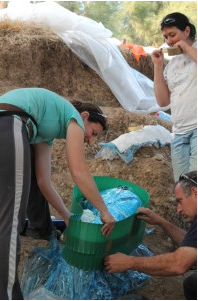Conservation
Conservation activities in the collections
Conservation activities in the collections include:
(1) Preventive care that includes issues such as control of environmental conditions, optimal storage, ongoing maintenance and participation in the planning of designated spaces for collections.
(2) Direct handling of the various collection items includes conservation work mainly in the paleontological, archaeozoological and zoological collections, but also in the other collections.
(3) Research in the field of conservation for the development and improvement of methods for the conservation and treatment of nature collections.
(4) Advice and training for applicants as well as for museums and small collections.
As a result of these tasks, the collections shift accompanies excavation expeditions to handle findings in the field as well as goes on consulting visits and handling external collections.
Ms. Gali Beiner (MA, ACR), serves as the National Natural Collections Supervisor at the Hebrew University full-time since 2009. Gali's work experience includes a wide variety of materials and exhibits, from places such as the Bristol City Museum of Art and Archaeology, the Liverpool Conservation Center, the Israel Museum, The Pitt Rivers Museum of Ethnography in Oxford, the Israel Antiquities Authority and the Museum of the Biblical Lands in Jerusalem. Gali has a master's degree in conservation archeology from Durham University (England).
The field of preservation is not the same as the field of preparation. Preparation in nature collections usually includes handling collected zoological specimens and putting them into collections in ways such as hatching and taxidermy, or preserving them in liquid. In the past, expeditions of collectors used to go out and hunt animals in order to increase nature collections. Nowadays, hunting for collection is not customary, but animals that have already died are collected - for example in car accidents. The National Nature Collections at the Hebrew University devote a lot of work to efforts to preserve nature and wildlife in Israel. As part of these efforts, we encourage people interested in fossils not to disconnect such finds from their natural context, but to contact the collections team in order to check and research interesting fossils observed in the field. By researching findings while fully recognizing the environment in which they were found, we can preserve nature and fossils in Israel and expand our knowledge about them.In some cases we will prefer to leave findings in place - and in other cases we will work to send out an expedition for the purpose of excavating and removing findings from the area as part of an organized study that takes into account all the information that can be extracted from the environmental context, taking into account questions such as whether the findings can be preserved while remaining in the field or whether it is better to remove them and preserve them in nature collections Nationals at the Hebrew University.

Several articles were published in the popular media telling about our activities outside the campus:
https://youtu.be/A8G06IsH59A
https://www.ynet.co.il/environment-science/article/SyXrViEYd
https://www.haaretz.co.il/gallery/.premium-MAGAZINE-1.10106875?utm_source=Web_Share&utm_medium=Whatsapp&utm_campaign=Share
Scientific publications:
Beiner, G.G. Labels for eternity: testing printed labels for use in wet collections. Collection Forum 34(1):101-113 https://doi.org/10.14351/0831-4985-34.1.101.
Rabinovich, R., Herzlinger, G., Calvo, R., Rivals, F., Mischke, S. and G. Beiner. Erq el Ahmar Elephant Site – A mammoth skeleton at a rare and controversial Plio-Pleistocene site along the mammal migration route out of Africa. Quaternary Science Reviews (2019) vol., 221. https://doi.org/10.1016/j.quascirev.2019.105885
Beiner, G.G., Lavi, M., Seri, H., Rossin, A., Lev, O., Gun, J., and R. Rabinovich. Oddy Tests: Adding the Analytical Dimension. Collections Forum (2015) vol. 29 no. 1-2, pp. 22-36.
Beiner, G.G. and R. Rabinovich. Bones and sediments: part of a synergetic continuum. Journal of Paleontological Techniques (2014) vol. 13 19-28, http://www.jpaleontologicaltechniques.org/pasta3/JPT%20N13/pdf/JPT13_pg_19_28.pdf
Beiner, G.G. and R. Rabinovich. An elephant task - conservation of elephant remains from Revadim Quarry, Israel. Journal of the Institute of Conservation (2013) vol. 36 no. 1, http://dx.doi.org/10.1080/19455224.2013.796887
Bar Oz, G. Beiner and L. Horwitz, The excavation and conservation of animal bones from archaeological sites Chapter In press for Horowitz L. and G. Bar-Oz eds.
Beiner, G. G. and R., Rabinovich. Natural History Conservation in Jerusalem. SPNHC Newsletter (2012) vol. 26(2) pp. 1-2 and 14.
Beiner, G. Indian Mica Paintings. The Friends of the PRM Newsletter (2007) vol. 58 p. 7.
Beiner, G. Mica Paintings Revisited. ICON News (2007) issue 9 pp. 25-28
Beiner, G. and Ticca M.O Ogilvie. Thermal methods of pest eradication: their effect on museum objects, The Conservator (2006) vol. 29 pp. 5-18